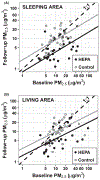Effectiveness of portable HEPA air cleaners on reducing indoor PM2.5 and NH3 in an agricultural cohort of children with asthma: A randomized intervention trial
- PMID: 32996146
- PMCID: PMC8641645
- DOI: 10.1111/ina.12753
Effectiveness of portable HEPA air cleaners on reducing indoor PM2.5 and NH3 in an agricultural cohort of children with asthma: A randomized intervention trial
Abstract
We conducted a randomized trial of portable HEPA air cleaners with pre-filters designed to also reduce NH3 in non-smoking homes of children age 6-12 with asthma in Yakima Valley (Washington, USA). Participants were recruited through the Yakima Valley Farm Workers Clinic asthma education program. All participants received education on home triggers while intervention families additionally received two HEPA cleaners (child's sleeping area, main living area). Fourteen-day integrated samples of PM2.5 and NH3 were measured at baseline and one-year follow-up. We fit ANCOVA models to compare follow-up concentrations in HEPA vs control homes, adjusting for baseline concentrations. Seventy-one households (36 HEPA, 35 control) completed the study. Most were single-family homes, with electric heat and stove, A/C, dogs/cats, and mean (SD) 5.3 (1.8) occupants. In the sleeping area, baseline geometric mean (GSD) PM2.5 was 10.7 (2.3) μg/m3 (HEPA) vs 11.2 (1.9) μg/m3 (control); in the living area, it was 12.5 (2.3) μg/m3 (HEPA) vs 13.6 (1.9) μg/m3 (control). Baseline sleeping area NH3 was 62.4 (1.6) μg/m3 (HEPA) vs 65.2 (1.8) μg/m3 (control). At follow-up, HEPA families had 60% (95% CI, 41%-72%; p < .0001) and 42% (19%-58%; p = .002) lower sleeping and living area PM2.5 , respectively, consistent with prior studies. NH3 reductions were not observed.
Keywords: HEPA cleaners; NH3; PM2.5; asthma; children; randomized trial.
© 2021 John Wiley & Sons A/S. Published by John Wiley & Sons Ltd.
Conflict of interest statement
CONFLICT OF INTEREST
Each author confirms that s/he has no conflict of interest.
Figures


References
-
- Eguiluz-Gracia I, Mathioudakis AG, Bartel S, et al. The need for clean air: the way air pollution and climate change affect allergic rhinitis and asthma. Allergy. 2020;75(9):2170–2184. - PubMed
-
- Habre R, Moshier E, Castro W, et al. The effects of PM2.5 and its components from indoor and outdoor sources on cough and wheeze symptoms in asthmatic children. J Expo Sci Environ Epidemiol. 2014;24(4):380–387. - PubMed
Publication types
MeSH terms
Substances
Grants and funding
LinkOut - more resources
Full Text Sources
Other Literature Sources
Medical
Miscellaneous

